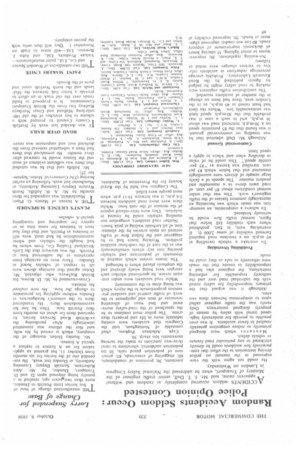Random Accidents Seldom Occur : Police Opinion Contested
Page 42

If you've noticed an error in this article please click here to report it so we can fix it.
ACCIDENTS seldom occurred completely at random and without apparent cause, said Mr. J. T. Duff, senior traffic engineer of the Ministry of Transport, when he addressed the National Safety Congress in London on Wednesday.
He could not agree with the view expressed in the manual on police driving instruction to the effect that comparatively few accidents could be directly attributed to any particular road feature or vehicle defect.
Measures which were designed primarily to reduce congestion generally resulted in fewer accidents. It was even possible to provide for moderately highspeed travel with safety by means of properly designed motorways. Only rarely was the traffic engineer called upon to compromise between these two aims.
Although it was argued that the primary responsibility for safety rested with the individual road user and the authority responsible for enforcing restrictions, the engineer also had a responsibility to ensure that the roads were inherently as safe as they could be made.
Prohibiting Overtaking
To overtake a vehicle travelling at 60 m.p.h. on a two-lane road required forward visibility of some 2,000 ft. If overtaking were, in fact, prohibited where such visibility fell below that figure, normal traffic flow would be seriously hindered.
To achieve a compromise, an assumption was made which was becoming an increasingly common feature of the traffic engineer's work. This was that under normal conditions about 85 per cent. of road users drove in a reasonable and prudent manner. The speeds of a fairly large sample of drivers were accordingly measured and that below which 85 per cent. travelled was known as "85 percentile speed." This could be of value in deciding when and where to apply a speed limit.
Controversial Ground Although Mr. Duff admitted that he was treading on controversial ground, it was found that the 85 percentile speed on a 30-m.p.h. restricted road was about 36 m.p.h., and in such a case it was probable that the 30-m.p.h. speed limit was unreasonably low. Where the limit had been raised to 40 m.p.h., as in the London area, there had been no change ill the number of accidents recorded.
The contribution traffic engineers were making to road safety might be judged by figures published by the Road Research Laboratory. Probable average percentage reductions in accidents relative to various changes were noted as follows:
No-waiting regulations, 30; improvements to street lighting, 35 (during hours of darkness); improvement of slippery roads. 80 (on wet roads); improved alignment at bends, 70; improved visibility at
junctions, 30; provision of roundabouts, 60; staggering of crossroads, 85; provision of pedestrian guard rails, 10 (in pedestrian accidents); alterations to rural three-way junctions to make the turning movements less sharp, 50.
Cant, Athelstan Popkess. chief constable of Nottingham, told the Congress that accidents were costing infinitely more in life and property than crime. The police must continue to be the spearhead of the road-safety movement and find ways of allocating resources of men and equipment to the work of traffic control and accident prevention proportionate to the injury which was being done to the community.
Whilst road accidents were under constant review, he questioned whether such energies were being wisely directed and the emphasis placed where it belonged.
The insane system which resulted in thousands of pedestrians and vehicles pouring into city streets simultaneously was at the root of the rush-hour accident problem. Working hours had to be staggered and the fullest flow of traffic secured on main arteries by the elimination of all kerbside waiting at peak hours.
Neither road accidents, congestion nor standing vehicles could be treated in isolation. They were inter-related aspects of the menace of the rush hour. Whilst there were more road accidents between 5-6 p.m., it was between 10-11 p.m. when most people were killed.
The Congress was held by the Royal Society for the Prevention of Accidents.




































































































